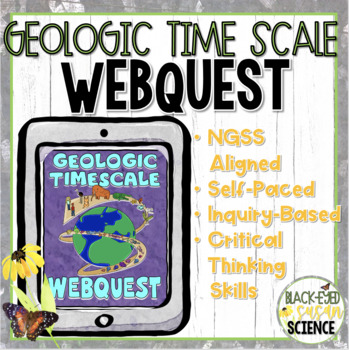Geologic Time Scale WebQuest
- Zip
- Internet Activities
- Webquests
What educators are saying
Also included in
- This is a custom bundle but you may purchase this custom bundle for yourself or request your own by emailing blackeyedsusanscience@gmail.com.Get exactly what you want and save money doing it!How to order your customized bundle: (It’s EASY)Step #1: Choose at least 10 items.Step #2: Email the list toPrice $96.00Original Price $142.00Save $46.00
- Enjoy all of my WebQuests at 30% off!!!Please look at each product description for details.Thank you for visiting Black-Eyed Susan Science!!!Price $87.50Original Price $125.00Save $37.50
Description
This WebQuest is a mini-unit all in itself. It's a great way to introduce or review the Geologic Time Scale. Help students understand what can be an abstract concept.
This WebQuest is also ideal sub plans!!
This engaging WebQuest can be completed individually, with partners, or in groups. The purpose of this WebQuest is for students to learn about the Geologic Time Scale, the events that are included, and how it is arranged.
Some topics in this WebQuest:
*strata
*Law of Superposition
*relative dating
*fossils
*fossil record
*mass extinctions
*eons, eras, periods, and epochs
*ice ages
*asteroid strike
*age of Earth
*oldest known fossil
*oldest human fossil
This activity guides students through exploring information and videos through the use of embedded links and QR Codes. Students are led through components of a WebQuest: introduction, task, process, final task, and conclusion. As a final task, students are asked to complete a calendar that represents the time scale.
Assign through Google Classroom or print copies for students.
Comprehensive answer keys included.
Customer Tips:
Get TPT credit to use on future purchases:
- Please go to your My Purchases page (be sure you are logged in). At the top of the page you'll see a box and the message “Give feedback on recent purchases”. Simply click the “GIVE FEEDBACK” button and you will be taken to a page where you can give a quick rating and leave a comment for the product. I highly value your feedback. It helps me to make resources that meet your needs.
- Also, be the first to know about new resources, freebies, and sales - just click the green star at the top of the page next to the Black-Eyed Susan Science logo. You will then receive customized email updates about my new products.
Thank you for visiting Black-Eyed Susan Science!







